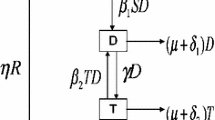Abstract
A mathematical model for the spread of alcoholism and smoking is designed and analysed to gain insights into this growing health and social problem. The reproduction number and equilibria states of the model are determined and their local asymptotic stabilities investigated. Analysis of the reproduction number have shown conditions under which encouraging and supporting moderate alcohol drinkers (smokers) to quit alcohol consumption (smoking) is more effective in the control of alcoholism (smoking) than supporting and encouraging alcoholics (smoking addicts) to quit and vice-versa. Numerical simulations show that smoking greatly enhances alcoholism and vice-versa. Thus, as shown by the numerics encouraging and supporting all smokers (alcohol drinkers) to quit smoking (alcohol drinking) also contribute meaningfully to alcohol (smoking) control programmes.
Similar content being viewed by others
References
Benedict, B.: Modeling alcoholism as a contagious disease: how infected buddies spread problem drinking. SIAM News 40(3) (2007)
Bhunu, C.P., Mushayabasa, S., Tchuenche, M.:. Assessing the effects of smoking on the transmission dynamics of Tuberculosis. Bull. Math. Biol. 73(6), 1333–1357 (2011)
Bhunu, C.P.: Mathematical analysis of alcoholism. WJMS 8(2), 124–134 (2012)
Bhunu, C.P., Mushayabasa, S.: Prostitution and drug (alcohol) misuse: the menacing combination. J. Biol. Syst. 20(2), 177–193 (2012). doi:10.1142/S0218339012500052
Bobo, J.K., Husten, C.: Sociocultural influences on smoking and drinking. Alcohol Res. Health 24(4), 231–232 (2000)
Botvin, G.J., Malgady, R.G., Griffin, K.W., Scheier, L.M., Epstein, J.A.: Alcohol and marijuana use among rural youth: Interaction of social and intrapersonal influences. Addict. Behav. 23(3), 379–387 (1998)
Brook, J.S., Whiteman, M., Gordon, A.S., Nomura, C., Brook, D.W.: Onset of adolescent drinking: A longitudinal study of intrapersonal antecedents. Adv. Alcohol Subst. Abuse 5(3), 91–110 (1986)
Carr, J: Applications Centre Manifold Theory. Springer, New York (1981)
Castillo-Chavez, C., Song, B.: Dynamical models of tuberculosis and their applications. Math. Biosci. Eng. 1(2), 361–404 (2004)
Conrad, K.M., Flay, B.R., Hill, D.: Why children start smoking cigarettes: predictors of onset. Br. J. Addict. 87(12), 1711–1724 (1992)
Ezzati, M., Lopez, A.D., Rodgers, A., Murray, C.J.L.: Comparative risk assessment group. Selected major risk factors and global and regional burden of disease. Lancet 360, 1347–1360 (2002)
Flay, B.R., Hu, F.B., Flaya, B.R., Phil, D., Richardson, J.: Psychosocial predictors of different stages of cigarette smoking among high school students. Prev. Med. 27, A9–A18 (1998)
Gritz, E.R., Prokhorov, A.V., Hudmon, K.S., Chamberlain, R.M., Taylor, W.C., DiClemente, C.C., Johnston, D.A., Hu, S., Jones, L.A., Jones, M.M., Rosenblum, C.K., Ayars, C.L., Amos, C.I.: Cigarette smoking in a multiethnic population of youth: methods and baseline findings. Prev. Med. 27(3), 365–384 (1998)
Gulliver, S.B., Kamholz, B.W., Helstrom, A.W.: Smoking cessation and alcohol abstinence: what do the data tell us. Alcohol Res. Health 29(3), 208–212 (2006)
Hill, A.L., Rand, D.G., Nowak, M.A., Christakis, N.A.: Infectious disease modelling of social contagion in networks. PLOS Comput. Biol. 6(11) (2010)
Hughes, J.R.: Combining behavioural therapy and pharmacotherapy for smoking cessation: an update. NIDA Res. Mononogr. 150, 92–109 (1995)
Hughes, J.R.: Treating smokers with current or past alcohol dependence. Am. J. Health Behav. 20, 286–290 (1996)
Hughes, J.R., Ross, G.L., Callas, P.W.: Nicotine is more reinforcing in smokers with a past history of alcoholism than in smokers without this history. ACER 24(10), 1633–1638 (2000)
Mittelmark, M.B., Murray, D.M., Luepker, R.V., Pechacek, T.R., Plate, P.L., Pallonen, U.E.: Predicting experimentation with cigarettes: the childhood antecedents of smoking study (CASS). Am. J. Public Health 77(2), 206–208 (1987)
Mokdad, H.A., Marks, S.J., Stroup, D.F., Gerberding, J.L.: Actual causes of death in the United States of America, 2000. J. Am. Med. Assoc. 291(10), 1238–1245 (2004)
Qiu, Z., Yu, J., Zou, Y.: The asymptotic behavior of a chemostat model. Disc. Cont. Dynam. Syst. - Ser. B4(3), 721–727 (2004)
Room, R.: Smoking and drinking as complementary behaviours. Biomed. Pharmacother. 58, 111–115 (2004)
Scaffa, M.E.:. Adolescents and alcohol use. In: Henderson, A., Champlin, S., Evashwick, W. (eds.) Promoting Teen Health: Linking Schools, Health Organizations and Community, pp. 78–99. SAGE, Thousand Oaks (1998)
Sharomi, O., Gumel, A.B.: Curtailing smoking dynamics: a mathematical modeling approach. Appl. Math. Comput. 195(2), 475–499 (2008)
Shiffman, S., Balabanis, M.: Association between alcohol and tobacco. In: Ferting, J.B., Allen, J.P. (eds.) Alcohol and Tobacco: From Basic Science to Clinical Practice (NIH Publication 95-397), pp. 17–37. United States Department of Health and Human Services, Washington, D.C. (1995)
Unger, J.B., Chen, X.: The role of social networks and media receptivity in predicting age of smoking initiation: a proportional hazards model of risk and protective factors. Addict. Behav. 24(3), 371–381 (1999)
van den Driesche, P., Watmough, J.: Reproduction numbers and sub-threshold endemic equilibria for the compartmental models of disease transmission. Math. Biosci. 180, 29–48 (2002)
Walsh, R.A., Bowman, J.A., Tzelepis, F., Lecathelinais, C.: Smoking cessation interventions in Australian drug treatment agencies: a national survey of attitudes and practices. Drug Alcohol Rev. 24, 235–244 (2005)
Wills, T.A., Shiffman, S.: Coping behavior and its relation to substance use: a conceptual framework. In: Shiffman, S., Wills, T.A. (eds.) Coping and Substance Use, pp. 3–24. Academic Press, New York (1985)
World Health Organization: Global Status Report on Alcohol. World Health Organization, Geneva (2004)
Zullino, D.F., Besson, J., Favrat, B., Krenz, S., Zimmermann, G., Schnyder, C., Borgeat, F.: Acceptance of an intended smoking ban on an alcohol dependence clinic. Eur. Psychiatr. 18, 255–257 (2003)
Author information
Authors and Affiliations
Corresponding author
Rights and permissions
About this article
Cite this article
Bhunu, C.P., Mushayabasa, S. A Theoretical Analysis of Smoking and Alcoholism. J Math Model Algor 11, 387–408 (2012). https://doi.org/10.1007/s10852-012-9195-3
Received:
Accepted:
Published:
Issue Date:
DOI: https://doi.org/10.1007/s10852-012-9195-3




